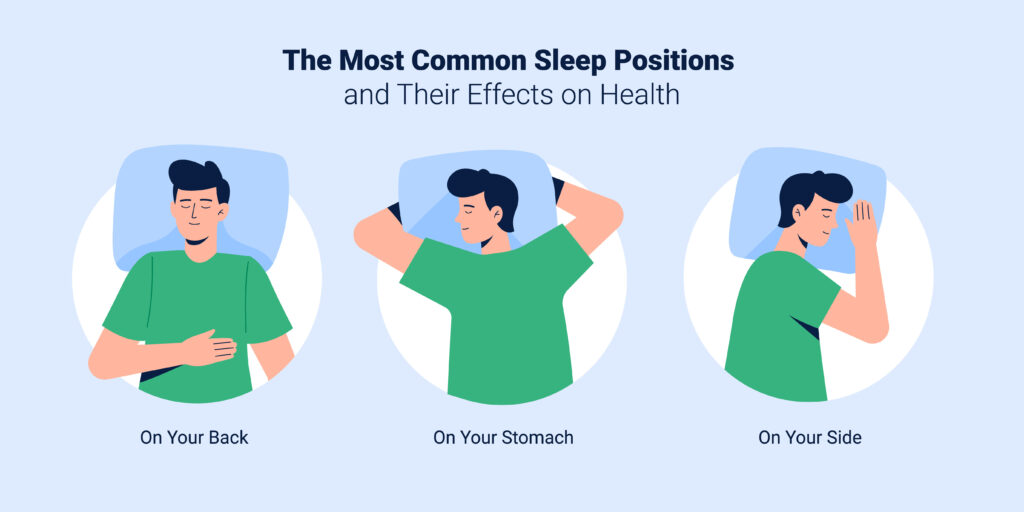Sleep
What is the Best Sleeping Position?
The best sleeping position can vary from person to person, but understanding how your sleeping position impacts your body can help you make a more informed choice. Whether you’re a back sleeper, side sleeper, or stomach sleeper, your sleeping position plays a key role in your overall comfort, sleep quality, and even how you feel the next day. The right sleeping position not only promotes better rest but also helps you avoid discomfort and supports your long-term health

What’s the Best Sleeping Position for Comfort and Support?
Everyone has their preferences when it comes to sleeping position, but a good sleeping position is one that provides proper spinal alignment, allows you to breathe easily, and supports your body’s natural curves. It’s important to find a position that suits your body and minimizes pressure points to avoid stiffness or discomfort when you wake up. The most common sleeping positions are back sleeping, side sleeping, and stomach sleeping.
Back Sleeping Position: Pros and Cons
Sleeping on your back, also known as the supine position, is often considered ideal for maintaining spinal alignment. In this position, your head, neck, and spine are aligned, which can reduce the risk of experiencing back or neck pain. For many, it is the most natural position for maintaining good posture while asleep.
However, there are a few things to consider. For example, if you suffer from snoring or mild sleep apnea, this position may not be the most beneficial. Back sleeping can worsen these issues by encouraging the airway to narrow or become obstructed.
Side Sleeping Position: Pros and Cons
The side sleeping position is the most commonly chosen sleeping position, and for good reason. This position can help reduce snoring and alleviate pressure on the heart, making it beneficial for overall health. Side sleeping is particularly good for people who suffer from acid reflux or heartburn, as it prevents stomach acid from traveling into the esophagus.
However, side sleeping can sometimes put pressure on the shoulder and hip joints, leading to discomfort. If you choose this position, consider using a pillow between your knees to reduce strain on your hips and lower back. Side sleeping is often a great choice for those who experience discomfort in other positions, as long as you maintain proper body alignment.
Stomach Sleeping Position: Pros and Cons
Stomach sleeping, or the prone position, tends to put the most strain on your neck and spine, making it one of the least recommended sleeping positions for long-term health. This position forces your neck to twist to one side and can lead to discomfort and misalignment, which could cause stiffness or pain over time.
However, some people find stomach sleeping to be the most comfortable for them, especially if they experience issues with snoring or breathing. If this is your preferred sleeping position, try using a very thin pillow or no pillow at all to keep your neck in a more neutral position and reduce strain on the spine.
Factors to Consider When Choosing the Best Sleeping Position
In addition to your sleeping position, other lifestyle factors can support better sleep and overall health. Here’s how nutrition, supplements, and habits can play a role in improving your sleep quality, no matter your preferred sleeping position.
Magnesium Bisglycinate for Relaxation:
Magnesium helps relax muscles and calm the nervous system, making it an excellent choice for anyone looking to enhance sleep quality. If you struggle with sleep, magnesium bisglycinate supplements can promote relaxation, helping you fall into a deeper, more restful sleep regardless of your sleeping position.*
Herbal Supplements:
Supplements like ashwagandha, chamomile, and passionflower have been traditionally used for their calming properties. They can help reduce stress and promote a state of relaxation, making it easier for you to sleep soundly in whichever position you prefer.*
L-Theanine and 5-HTP:
L-theanine, an amino acid found in tea, is known for its ability to promote relaxation without sedation. It can help ease anxiety and calm your mind before bedtime. 5-HTP, a precursor to serotonin, may also support healthy mood regulation and sleep.*
Sleep Hygiene and Routine:
Creating a sleep-friendly environment and following a regular sleep schedule is crucial, regardless of your sleeping position. Keep your bedroom dark, quiet, and cool, and avoid heavy meals or caffeine close to bedtime to improve sleep quality. Consistent sleep habits support deeper rest, helping you wake up feeling refreshed.
Diet and Nutrition:
Eating a balanced diet rich in sleep-promoting nutrients, such as foods high in tryptophan (like turkey or nuts), can help improve sleep quality. Nutrients like magnesium and B vitamins also support overall sleep health and can help your body relax, leading to a more restful night’s sleep.
Overview
Choosing the best sleeping position is a personal decision that depends on your comfort and any specific health considerations you may have. Whether you prefer sleeping on your back, side, or stomach, the goal is to find a position that allows for proper spinal alignment and reduces discomfort.
In addition to optimizing your sleeping position, a healthy lifestyle that includes a balanced diet, supplements like magnesium bisglycinate or ashwagandha, and a consistent sleep routine can help you achieve more restful sleep. When combined, these practices support your body’s natural processes, helping you wake up refreshed and ready to tackle the day, no matter how you sleep.*
Sources:
Like? Share with Your Friends!

